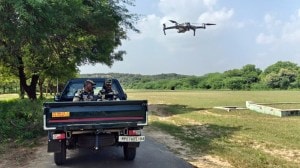Now, pillow bombs feared on planes
Airport screeners in US and elsewhere are on the lookout for suspicious pillows, coats and stuffed animals after US intelligence concluded t...

Airport screeners in US and elsewhere are on the lookout for suspicious pillows, coats and stuffed animals after US intelligence concluded that Al Qaeda operatives are being trained to apply special chemicals to the material inside to transform them into bombs.
US Intelligence officials have picked up several indications that Al Qaeda is attempting to create a chemical called “nitrocellulose” to fashion explosives that could be smuggled aboard jetliners, according to a warning the Department of Homeland Security sent to airport security officials around the world.
‘‘We judge this type of threat to be real and continuing,’’ the department said in the August 8 warning. It noted there has been ‘‘persistence (in a) line of reports from several credible, independent sources’’ that Al Qaeda is training to build such bombs. Confiscated Al Qaeda training manuals show the sophistication of its preparations, the document said. Explosives experts said the detonating power of a nitrocellulose bomb depends on numerous factors — but mostly on how tightly the cotton-like material is packed. Large wads of it crammed into a container could create a detonation.
‘‘It has to be confined in an area to be explosive,’’ said Gregory G. Baur, a former director of International Association of Bomb Technicians and Investigators. Items such as buttons, zippers or wristwatches could be used in tandem with tightly packed nitrocellulose as power sources or ignition components to set off a detonation, the directive said.
US officials said while airport X-ray machines cannot detect nitrocellulose, another type of technology called a trace-detection machine can. Screeners rub the inside of, say, a briefcase or jacket with a specially treated cotton swab or piece of gauze and then insert the swab into the machine. The machine heats the swab and can detect from the vapours whether explosive chemicals or narcotics are present.
The Homeland Security Department’s Transportation Security Administration (TSA) has purchased several thousand such machines in the past year as part of an effort to check for explosives in luggage. Nitrocellulose, also called guncotton or cellulose nitrate, can be created by combining cotton with nitric acid or sulphuric acid, substances that are used in various forms to clean drains and by artists in metal etching.
Mixing in nitroglycerine makes the mixture dangerous. If dried carefully, it emits no odour, but if dried incompetently, it has a slight ether-like smell, the memo said.
TSA spokesman Brian Turmail said his agency and its predecessor, the Federal Aviation Administration, have circulated memos on the threat of explosives hidden in clothing or toys for three years.
‘‘This is a threat that has been anticipated in the design and development of the procedures our screeners follow,’’ he said. That’s why passengers are asked to remove their jackets and place them, a well as stuffed animals and pillows, on X-ray machines, he said.(LAT-WP)
Photos





- 01
- 02
- 03
- 04
- 05

























